Many baristas overlook the importance of consistent practice and mastering basic techniques like milk steaming, microfoam, and steady movements. Pros focus on perfecting their foam texture, controlling pouring angles, and building muscle memory through drills. Observing skilled baristas and analyzing their techniques also help refine skills. If you keep working on these fundamentals, you’ll improve faster. Keep going, and you’ll learn the key steps to elevate your latte art from amateur to professional.
Key Takeaways
- Prioritize mastering milk steaming and microfoam consistency for smooth, velvety textures essential for latte art.
- Develop steady pouring movements and control your hand to create sharp, precise patterns.
- Practice basic shapes like hearts and rosettas repeatedly to build confidence and foundational skills.
- Analyze professional techniques by observing wrist movements, pitcher angles, and posture for better control.
- Incorporate regular drills and seek feedback to refine your technique and ensure consistent, high-quality pours.
Understanding the Fundamentals of Milk Steaming
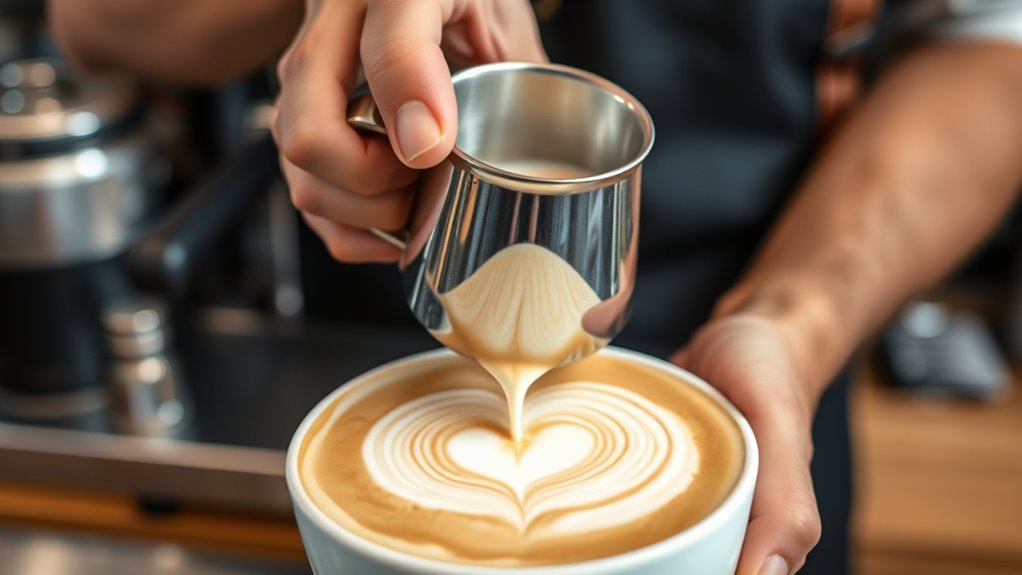
To create smooth, glossy milk for latte art, you need to understand the fundamentals of milk steaming. Foam stability is essential; well-steamed milk should have a velvety texture that holds its shape. Achieving this requires controlling milk temperature precisely, usually between 140°F and 150°F. If the milk gets too hot, proteins break down, causing foam to collapse and losing its stability. Too cold, and the foam won’t develop fully, making it hard to create detailed designs. As you steam, focus on introducing microfoam by positioning the steam wand just below the surface, creating tiny bubbles. Consistent temperature and foam stability are key to producing milk that flows smoothly and forms beautiful latte art. Mastering these basics sets a solid foundation for advanced latte art skills.
Perfecting the Consistency of Your Microfoam
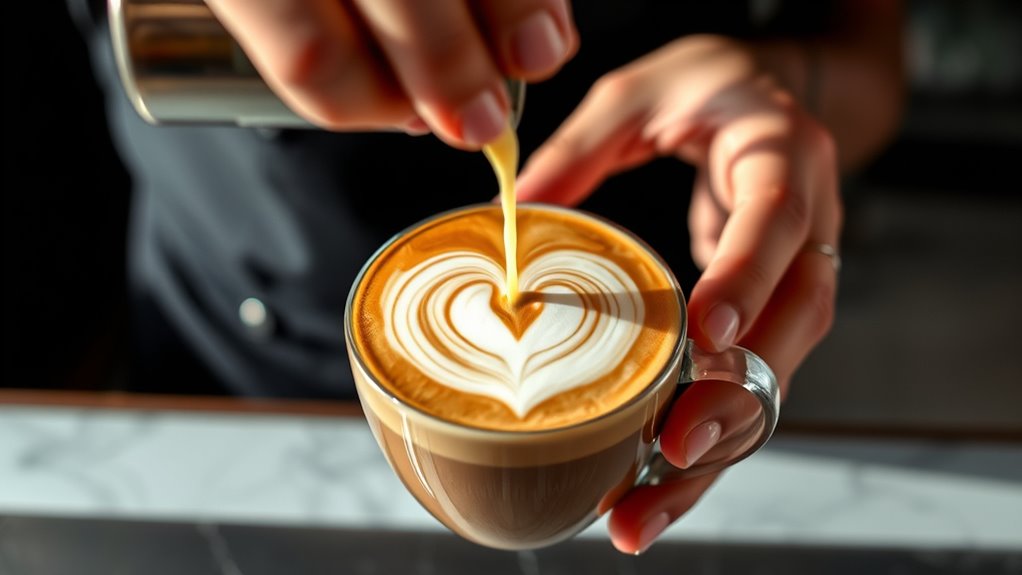
Achieving consistent microfoam starts with fine-tuning your steaming technique to produce a smooth, velvety texture every time. Focus on controlling milk temperature, aiming for around 140-150°F, to guarantee your milk steams evenly and avoids overheating. Proper milk temperature helps maintain ideal foam quality and prevents a burnt taste. Pay close attention to foam density; it should be silky and fine, without large bubbles or separation. Consistent foam density allows for seamless pouring and better latte art. Use a thermometer to monitor temperature and adjust your technique accordingly. Steaming milk with the right temperature and foam density takes practice, but mastering these elements will give you a solid foundation for creating the perfect microfoam every time. Understanding French Press Operation can also inspire new brewing techniques that enhance overall coffee experience.
Practicing Basic Shapes Before Moving to Complex Designs
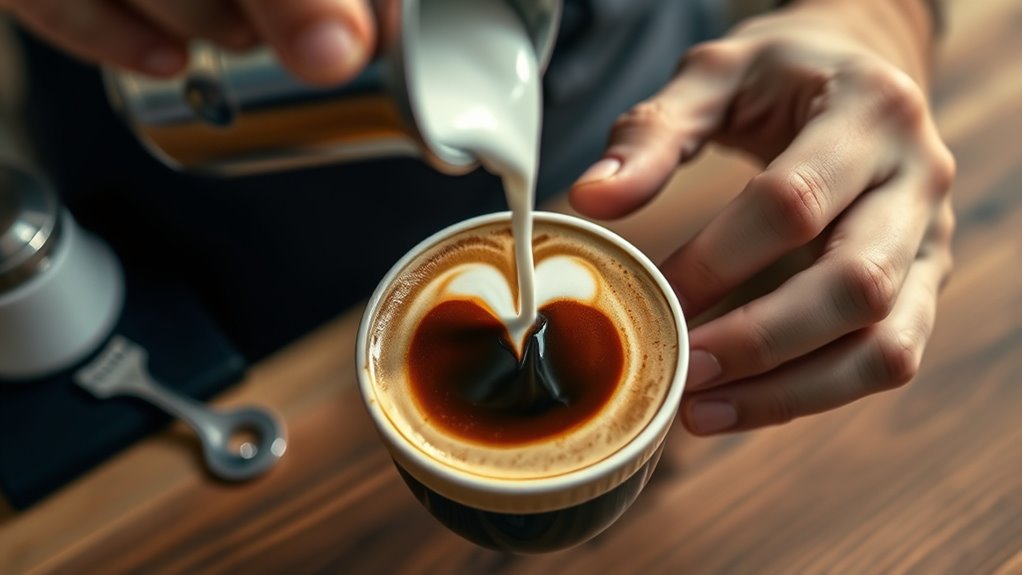
Start by mastering simple shapes like hearts and rosettas to build your confidence. Focusing on these basics helps you solidify your fundamental techniques before tackling more complex designs. Remember, consistent practice of simple motifs sets a strong foundation for advanced latte art. Incorporating basic design principles can further enhance your skills and creativity.
Master Simple Motifs First
Before diving into intricate designs, focusing on simple motifs allows you to build a solid foundation for your latte art skills. Start by practicing basic shapes like hearts, rosettas, and tulips. Achieving clean, consistent motifs depends heavily on proper milk frothing and foam texture. Use milk that’s steamed to a silky, microfoam consistency, ensuring the foam is smooth and free of large bubbles. This helps you control the pour better and create clear, defined shapes. Mastering these simple motifs lets you develop steady hand movements and better control over your milk flow. Once you feel confident with basic patterns, you’ll find it easier to tackle more complex designs. Remember, good lighting and a steady hand are crucial in developing precision in your latte art. Consistency and precision in these simple forms are key to progressing in your latte art journey.
Build Confidence Gradually
Building confidence in your latte art begins with mastering basic shapes, as they serve as the foundation for more complex designs. Confidence building comes from consistent practice of simple motifs like hearts, rosettas, and tulips. When you focus on these fundamentals, you develop essential skills that translate to more intricate patterns later. Don’t rush to create perfect designs right away; instead, aim for steady improvement. As you repeat basic shapes, you’ll notice your skill development accelerates, making you more comfortable with the pouring process and control. This gradual approach boosts your self-assurance and reduces frustration. Remember, building confidence is a step-by-step journey—mastering the basics first guarantees a solid base for more advanced latte art. Additionally, understanding anime movies can inspire creativity and patience, both of which are valuable in perfecting your craft.
Solidify Fundamental Techniques
Focusing on mastering basic shapes lays a strong groundwork for more complex latte art designs. When you perfect these fundamentals, your pours become more consistent, enhancing your coffee flavor presentation and earning better customer feedback. Don’t rush to create intricate patterns—solidify your skills first.
- Feel the confidence grow as your basic shapes become second nature, making each pour more precise.
- Notice how improved technique elevates the overall coffee experience for your customers.
- Experience the satisfaction of seeing your progress reflected in genuine customer feedback and repeat orders.
Using the Right Tools and Equipment for Precision

Having the right tools and equipment is essential for achieving precise latte art. Start with your pitcher design; a well-shaped pitcher with a narrow spout allows for better control and more intricate pours. Consistency in milk temperature, ideally around 150°F to 155°F, ensures smooth, glossy microfoam that’s easy to manipulate. Using the right thermometer helps you maintain this temperature, preventing over- or under-steaming. A clean, well-maintained pitcher prevents unwanted streaks and ensures smooth pours. Additionally, investing in quality cups with a wide opening can improve your pouring accuracy. Proper tuning of your equipment and techniques can significantly elevate your latte art. These tools work together to give you the control needed for detailed designs. Remember, precision begins with the right equipment—choose wisely to refine your latte art skills.
Developing a Steady Hand and Controlled Movements
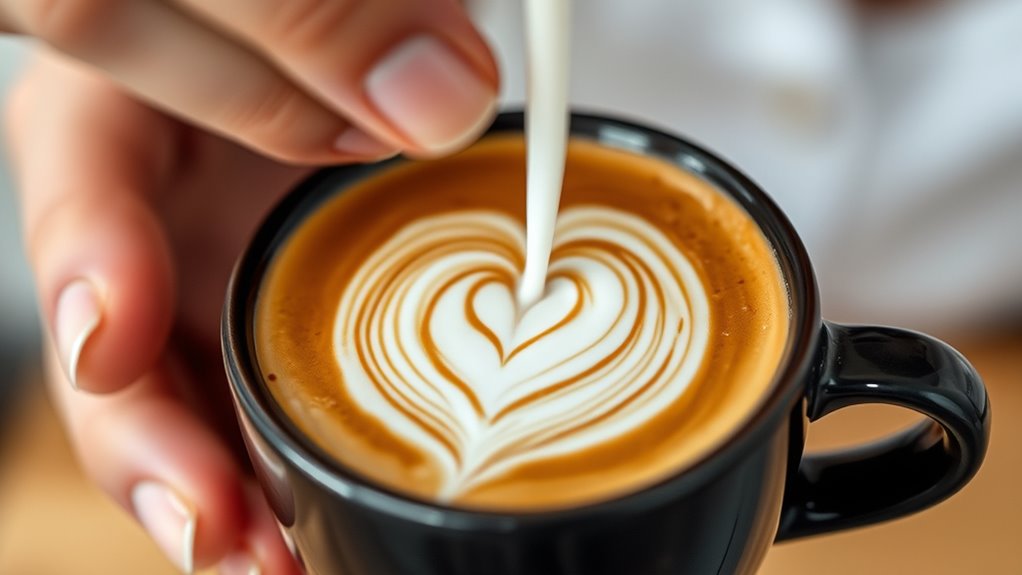
To improve your latte art, focus on maintaining a consistent hand position to guarantee stability. Use gentle, steady pours to control the flow of milk and prevent splashes. Move your hand smoothly and at a controlled speed to create precise, clean designs. Practicing with timing aids can help refine your pouring rhythm and improve overall accuracy.
Consistent Hand Positioning
Maintaining a consistent hand position is essential for creating smooth, even latte art. Your hand positioning and grip consistency directly influence the precision and fluidity of your designs. When your grip shifts or wavers, it disrupts your control, making your patterns uneven or shaky. To develop steady hand movements, focus on keeping your grip relaxed yet firm, avoiding unnecessary tension. Regularly check your hand placement to ensure it remains stable throughout each pour. Remember, small adjustments in hand positioning can considerably improve your results. With deliberate practice, you’ll build muscle memory, making your movements more controlled and confident. Cultivating a digital-friendly environment can also help you access helpful tutorials and resources to refine your technique.
- Feel the confidence in every steady movement.
- Watch your designs become more precise and beautiful.
- Experience the pride of mastering each latte art pattern.
Gentle Milk Pouring Technique
A gentle milk pouring technique is essential for developing a steady hand and controlled movements in latte art. When you pour softly, you control foam temperature and milk texture better, leading to cleaner designs. Keep your hand steady, and focus on smooth, consistent flow. Properly textured milk flows evenly, making it easier to create intricate patterns. Use the table below to understand key pouring aspects:
| Key Factors | Tips |
|---|---|
| Foam Temperature | Keep between 140-150°F for ideal pourability |
| Milk Texture | Aim for silky, microfoam consistency |
| Pouring Speed | Start slow, then increase steadily |
| Hand Stability | Maintain a steady, gentle motion |
Mastering this technique will help you produce beautiful latte art with control and finesse. Additionally, paying attention to color accuracy during steaming can enhance the visual appeal of your latte art by ensuring the milk’s hue complements your design.
Controlled Movement Speed
Developing a steady hand and controlled movements is key to creating clean, precise latte art designs. When you focus on speed control, you can avoid messy pours and uneven lines. Maintaining a consistent movement speed helps you develop better movement precision, making your designs sharper and more professional. It’s about finding that perfect balance—neither rushing nor dragging your hand. Practicing self-awareness during each pour allows you to better monitor your pace and adjust accordingly.
- Feel confident in your control, knowing your steady pace creates perfect flow.
- Experience the satisfaction of flawless, crisp patterns that wow every time.
- Master the art of timing, turning simple pours into stunning works of art.
Observing and Analyzing Professional Latte Art Techniques

By carefully observing professional baristas, you can uncover the subtle techniques that make their latte art stand out. Visual analysis allows you to notice details like the fluidity of their wrist movements, the angle of their pitcher, and the pressure applied during pouring. Technique observation helps you understand how they control milk flow and create distinct patterns. Pay close attention to their posture, hand positioning, and timing, as these factors influence the precision of their designs. Watching videos of professionals in action can reveal nuances you might miss in real time. Developing a keen eye for these details is essential for mastering sound design techniques that enhance your creative projects. By breaking down their movements and choices, you’ll gain insight into what sets their latte art apart and how you can adapt similar techniques to improve your own skills.
Incorporating Practice Drills Into Your Routine
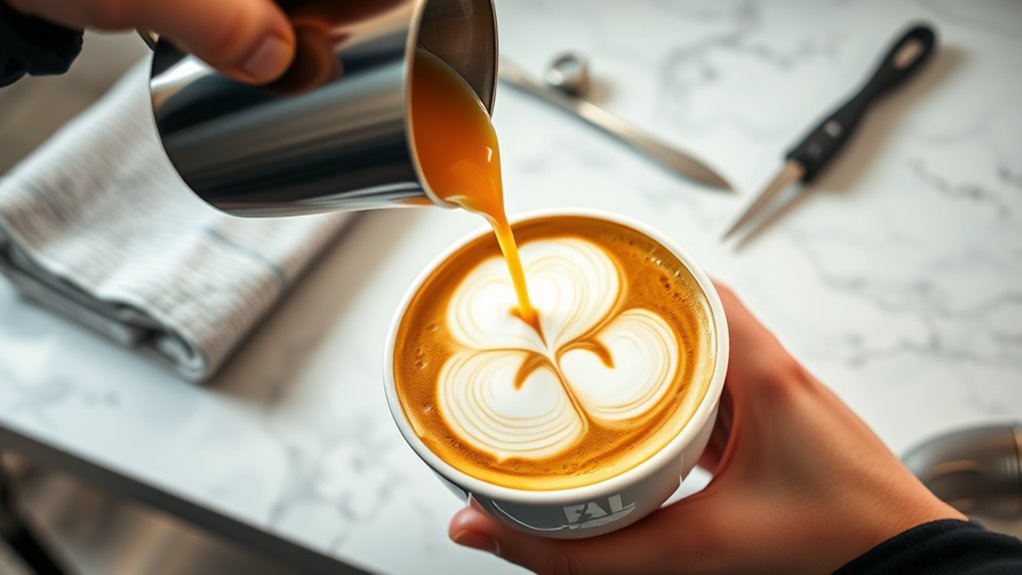
To see real improvement in your latte art skills, you need to intentionally incorporate practice drills into your routine. Focus on speed drills to build your pouring confidence and accuracy under time pressure. Consistency exercises help you develop a steady hand, ensuring each pour is smooth and uniform. Regularly dedicating time to these drills sharpens your technique and elevates your art. Incorporating specialized equipment like precision pouring tools can further enhance your control and results.
- Push yourself with timed speed drills to boost your confidence and efficiency
- Practice consistency exercises to create flawless, uniform designs every time
- Track your progress to stay motivated and identify areas for improvement
Experimenting With Different Pouring Styles and Angles

Experimenting with different pouring styles and angles can dramatically expand your latte art repertoire. By adjusting pouring angles, you influence how the milk interacts with the espresso, creating unique patterns and textures. Experiment with a steeper angle for more control and sharper designs, or a flatter pour for smoother, broader shapes. Flow control is essential here—slow, steady pours allow you to refine each design, while quicker flows can produce bold contrasts. Changing your pour’s angle impacts both the shape and the detailing of your art, helping you develop a broader skill set. Don’t be afraid to test out various techniques; each adjustment teaches you something new about how milk flows and interacts with the crema. This experimentation is key to mastering your personal latte art style.
Maintaining Patience and Persistence Throughout the Learning Process
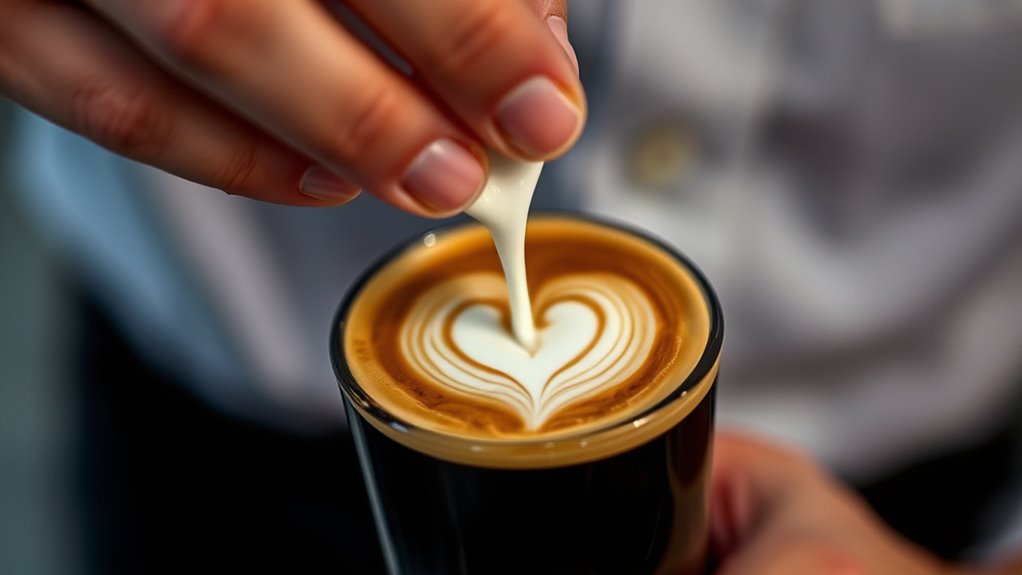
Learning latte art requires you to stay patient and persistent, especially when progress feels slow. Developing this skill demands a mindset shift, recognizing that mastery takes time. Keep reminding yourself that setbacks are part of the process, not an indication of failure. Persistence strategies like setting small goals, celebrating improvements, and practicing regularly help you stay motivated. Remember, even pros faced frustrations before perfecting their designs. Embrace the journey, knowing each pour brings you closer to your goal. Incorporating consistent practice routines can accelerate your growth and help solidify your skills. Visualize your success to stay inspired during tough days. Focus on incremental progress instead of perfection. Use setbacks as opportunities to learn and refine your technique.
Frequently Asked Questions
How Long Does It Typically Take to Master Basic Latte Art Skills?
It usually takes about 1 to 3 months to master basic latte art skills if you practice regularly. To improve, focus on controlling milk temperature and achieving the right foam consistency, which help create smooth, well-defined designs. Consistent practice, paying attention to milk texture, and perfecting your pouring technique are key. With dedication, you’ll see progress and start creating impressive latte art faster.
Can Latte Art Improve My Overall Coffee-Making Proficiency?
Latte art can definitely boost your overall coffee-making skills by enhancing your attention to detail, improving milk steaming techniques, and refining pour consistency. As you practice, you’ll notice better control over coffee flavor extraction, leading to richer taste and aroma. Additionally, mastering latte art increases customer satisfaction by creating visually appealing drinks. So, engaging in latte art elevates not just presentation but also your overall proficiency, making each cup a true craft.
Are There Common Mistakes Beginners Should Avoid in Latte Art?
You should avoid common mistakes like poorly frothed milk and shaky pouring techniques. Make sure your milk frothing creates a smooth, glossy microfoam without large bubbles. Practice steady, controlled pouring to shape your designs accurately. Rushing or tilting the cup too much can ruin your latte art. Focus on mastering milk frothing first, then refine your pouring techniques. Consistent practice helps you develop better control and results over time.
What Are the Best Ways to Get Feedback on My Latte Art Progress?
You should seek peer critique and watch video tutorials to get valuable feedback on your latte art progress. Sharing your work with fellow baristas or online communities allows you to receive constructive advice and spot areas for improvement. Additionally, recording your attempts and reviewing the videos helps you identify mistakes and track your growth. Combining peer critique with guided tutorials accelerates your learning and hones your skills faster.
How Often Should I Practice to See Consistent Improvement?
You should practice daily to see steady progress, as consistency is key to mastering latte art. Stick to a dedicated practice schedule, even if it’s just 15-20 minutes, to build muscle memory and improve skill consistency. Think of it as watering a plant—regular care yields the best growth. By making practice a habit, you’ll sharpen your skills faster and create beautiful designs with confidence.
Conclusion
Don’t overlook the importance of consistent practice—studies show that it takes about 10,000 pours to master latte art. By focusing on fundamentals, refining your technique, and experimenting with styles, you’ll see steady improvement. Remember, even pros started with simple shapes before creating intricate designs. Stay patient and persistent, and you’ll transform your latte art from basic to breathtaking in no time. Keep pouring, and enjoy the journey of perfecting your craft.









